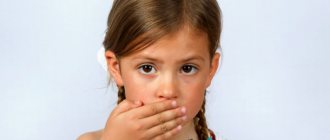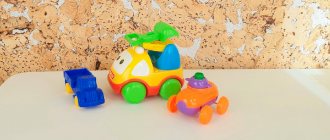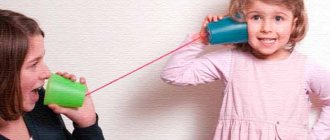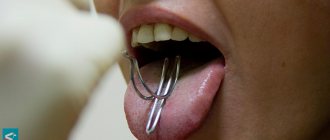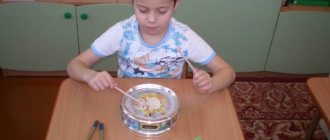Speech development in young children from birth to two years
How speech and communication develop at an early age, when and how to practice - this is a question that all parents ask.
Let's try to briefly answer these questions. You can find more detailed answers and recommendations in the books published by our organization. A study of the development data of children with Down syndrome shows that the majority of children have a violation of speech function, especially its expressive side*. In other words, it is known in advance that the child’s own speech will be impaired. This gives us the opportunity, by starting classes on time, to prevent or at least minimize these violations. Experience shows that the optimal age for starting classes to stimulate speech development is the first months of a baby’s life.
What are early childhood activities like?
First of all, this is interaction and communication with the child, which occurs while caring for him and playing with the baby. Closer to the year, short, specially organized classes are added, which are conducted in the form of a game.
Who will conduct the classes?
Whether you have a family educator or not, classes are taught by parents and other family members.
What does the development of young children depend on?
The development of a young child, including speech, is based on “three pillars”
First of all, let's call social-emotional development, namely, warm relationships with loved ones. Primary attachment not only affects the child’s subsequent relationships with the world of people, but also its entire development.
Next, we note sensory development - all types of sensation and perception, that is, sensory knowledge of the surrounding world
And finally, motor development - the child’s ability to reach and take objects, turn towards an object of interest, moving in space, explore it, set and realize goals, understand cause-and-effect relationships and much, much more.
Thus, we have the right to say that the socio-emotional and sensorimotor development of a young child are basic for his subsequent development, including speech development. All this makes it possible to assume that the approach to speech development should be based on emotional, sensory and motor stimulation of the child. *Note:
Expressive speech – own speech Impressive speech – understanding of addressed speech
Let's consider the sequence of development of a child's expressive speech:
Screams, grunting, short guttural sounds - hooting - arise independently from birth. Humming is a drawn-out pronunciation of vowels and syllables with guttural consonants (gu, agu, gee). Babbling - repeated repetition of chains of syllables, with labial and frontal consonants (ma-ma-ma, boo-bu-bu) Words - the transition to babbling words (mom, dad, bobo, bang, am, dai) occurs against the background of babbling. A word is any sound, syllable, or onomatopoeia that carries a semantic load. For example, repeating the syllables ma-ma-ma is babbling, but the same combination of syllables addressed to mom is already a word.
Expressive Vocabulary Growth
At the age of one year, a child can have from 3-5 to 7-9 words. After the appearance of the first words, vocabulary development may stop for 4-6 months. During this time, children learn to use their existing vocabulary by combining words with gestures and movements. After one and a half years, the number of words increases, and closer to two years, words from the adult lexicon appear: ba or baka (dog), mami (take), maka, may (small), bo (big). Children's first words are characterized by polysemanticism: the same sound combination in different cases expresses different meanings, and these meanings become understandable only thanks to the situation and intonation. For example, “ka-ka” can mean a swing (kach-kach), a crow (kar-kar), rain (drip-drip). In addition, a child can use the same sound combination to name any bird (by association with a crow), or an umbrella (by association with an umbrella). Grammatical structure. Later, phrases of two lexical units appear: “Lala bang” - the girl fell, “daddy u” - dad is sawing, “uncle drr” - uncle is driving a car. Children also use a combination of words and gestures, for example, to indicate the absence of a car, a child can say “drr” and show a “no” gesture
Step-by-step development of a child’s expressive speech
Newborn baby. Hooting period
- Carry the baby in your arms. Don't be afraid to spoil your baby.
- While caring for your child, attract his attention, talk to him, sing songs, smile. Remember that at this stage the child is attracted to smooth, melodious speech.
- Feeding time is a time for mother and baby to interact. Look at the baby, and when he looks at you, smile at him, say something kind. Breastfeeding on demand is ideal, but bottle feeding, if done correctly, will bring you many wonderful moments of complete closeness with your baby.
By the end of the first month, the baby is already reacting to the appeal to him: he stops crying and focuses on the adult.
From 2 to 3-4 months. Hooing, humming
- Draw your child's attention to your face. Call him, blow, cluck at the baby, waiting for his gaze, and, having waited, smile at the baby.
- Talk to your baby, conducting a kind of dialogue with him. When making different sounds, pause to give your baby the opportunity to respond to you.
- Be attentive to your child's signals; perhaps he also wants to communicate with you. This is evidenced by his look, smile, cooing sounds.
- While talking to the baby, tickle him and stroke him. Your speech and your smile, combined with tactile-motor stimulation, will help your baby smile at you.
- At this age, children enjoy smooth, melodious speech. They listen carefully to the intonation, not yet understanding the meaning of the speech.
If the child looks away or even turns away, this is a signal that he is tired and you need to take a break from communication. At this age, proper organization of feeding is very important.
From 3/4 to 7/8 months humming, babbling
- Play with your baby while sitting face to face; for this you can use a special chair with an inclined back (baby lounger, car seat). Sitting comfortably, the child will be happy to play and communicate with you.
- Massage the face and organs of articulation (see books for parents “Baby with Down syndrome” “Formation of communication and speech skills in children with Down syndrome”
- Use a combination of chains of movements with chains of syllables: when pronouncing syllables, for example, ba-ba-ba, ma-ma-ma, jump with the child. To do this, you can sit the child on a large ball, another springy surface, or simply on your lap.
- Shake the baby, this usually makes him laugh and shout loudly.
- Imitate the babble of a baby. When pronouncing labial sounds and syllables, draw the child's attention to your mouth.
The time has come when you must help your child connect the word with the content - developing speech understanding (you can read about this in the article about speech understanding/impressive speech)
From 9/10 to 12/14 months Babbling, first babbling words
- Motor development. At this age, the baby should spend most of his waking time on the floor. Encourage him to move around the room with interesting toys.
- Speech understanding. When talking to your baby, try to be laconic. Emphasize the key word with intonation. Sing songs and nursery rhymes, accompanying them with gestures.
- Inducing active babble. Draw the child's attention to your face, pronounce syllables with labial sounds: ba-ba-ba, ma-ma-ma. Pause, giving your baby the opportunity to repeat after you.
Until recently, parents were advised to use recordings of the babbling speech of another child or the baby himself. Recent research has shown that the real effect is listening to babble in the presence of a “carrier”, in other words, the child must see the person who pronounces these sounds. This is why Toddler groups have become so widespread, where kids have the opportunity to imitate the movements, actions and speech of their peers.
- Massage of the face and organs of speech. To activate the muscles of the face and mouth, we suggest you do a massage.
- Shake the child, throw him up, swing him on the ball, while simultaneously pronouncing babbling chains.
- Hand stimulation. Introduce finger games with your child. This will also stimulate his speech activity
- Organization of feeding. The organs of speech and the organs we use for eating are the same, so proper organization of feeding is important for the development of speech Development of imitation of movements. A child learns to speak by imitating the speech of an adult, including movements of the lips and tongue. This is especially noticeable if you watch how the baby carefully looks at the mother’s face.
The development of imitation of movements helps to develop the baby’s imitation abilities. Use alternating games for this - roll the ball to each other, alternately hit the drum. A combination of verbal cues, gestures and movements. Play nursery rhymes with movements, for example, “okay”. Use gestures, sounds, babbling words, onomatopoeia to indicate what is happening, for example, This is a car: drrrrr, / bibi. The car drives drrr + “steering wheel” gesture. Thus, the adult uses the full word, gesture, “children's word.”
From 12/14 to 18/20 months Babbling words. First simple words
Development of gross motor skills. Development of quality of movements. Walking, changing positions.
Speech development. Lists and tables are compiled that record the child’s speech development. List 1. Expressive vocabulary. The list includes all sounds, syllables and onomatopoeias that act as words. For example, if a child uses the lexeme “ka-ka” with different meanings (swing, swing - kach-kach, rain - drip-drip, crow - kar-kar) then this is recorded as three different words. List 2. Received the code name “babble” This list records all speech signals that do not carry a lexical load. For example, vavawa, tatata, etc. Based on lists 1 and 2, list 3 is compiled, which includes those sound combinations and words that are accessible to the child in terms of articulation. In this way, we can expand the child’s vocabulary by moving from babble to words. Analysis of the second and third lists help us take into account the articulatory capabilities of children.
An example of work on developing expressive speech
1 step. We encourage the child to use the words he already has.
Make a list of the words your child has and encourage their use in play and everyday life. List example #1:
Child's words/Meaning of words
- Mother
- Dad
- Woman
- Uncle
- Pampa
- A-a-a/dog
- Drrr/car
- Sniffles/hedgehog
- A_a_a/sleepTalk to your child using words from this list
Bring a specific meaning to the child’s babble: if the child says “mama,” the mother’s positive reaction should follow. React emotionally and positively to your child's spoken words. When your baby says a word, try to understand what he means and respond to his message. It is better if you turn to the child, look into his face and in one way or another confirm that you hear and understand him. For example, a child brings a car and says “beep.” You answer: Yes, this is a car, it buzzes “beep.” Children often ask adults to name this or that object. They point a finger at him, accompanying this with some kind of sound (mmm, uh, etc.). Name the subject that interests the child and your dialogue will take place.
Ask questions that encourage the use of first words. For example, someone rang the doorbell, or you heard the sound of a door opening, ask “Who came, who is it?” If the baby doesn’t answer, name it yourself (dad, grandma, etc.) Another example. The kid is rolling the car, you say: the car is going drrr, how is the car going? Step 2.
Make list No. 2. It will include syllables and syllable chains that do not make sense. As you remember, we called them “babies”. This could be, for example, a list like this:
- Vavava, dadada, nanny, uuuu, uh
Step 3.
Consider lists No. 1 and No. 2.
Write down what syllables your child can say. Based on these syllables, make list No. 3, which will include words new to the child. List #3 might look like this:
How does an adult pronounce / How does a child say
- Drum bam-bam-bam bam/ ba-ba-ba
- Fell bang bang/bang
- Swing, swing swing - swing swing
- Rain drip-drip-ka-ka
- Goose gagaga ha-ga
- Frog qua-qua wa-wa
- Give me, give me? yes/na
- Dog aw-aw aww, a-a
- Crow caw caw caw
- Sleep ah-ah, bye=bye bye, ahh
An adult must use full words in speech, accompanying them with onomatopoeias from lists No. 1 and No. 3, for example: “if you want to swing on a swing - swing-pitch”, “The baby is sleeping - bye-bye / a-a-a Step 4.
After some time, the child will begin to develop truncated and simplified words from the adult vocabulary, for example ba/baka/babaka, which means dog. In order for these words to become entrenched in your child’s vocabulary, you must not miss their appearance and actively include them in your communication with your baby. At the same time, a halophrase appears, when a child replaces an entire message with one word, for example, seeing a hammer, he says “dad.” This does not mean at all that the child has mixed up something, he is simply trying to say: “Dad banged with this hammer,” which means that you must decipher his message and then the baby will feel that he is understood. Encourage your child to use two-word constructions in play and everyday life: yaya bang (Lala fell), as well as statements consisting of two words or a word and a gesture.
Some patterns of speech development in young children
An indicator of the development of a child’s speech after the appearance of the first words is not correct sound pronunciation, as parents for some reason think, but the timely development in the child of the ability to use the words of his vocabulary in various combinations with each other, i.e. developing the ability to connect words into sentences.
A characteristic feature of children's speech up to 3 years of age is that many sounds of the native language are omitted or replaced by ones that are similar in sound or articulation. This happens because the articulation of sounds is not developed immediately, but gradually, and the perception of speech is far from perfect.
Children speak words consisting of available sounds:
- early ontogenesis of speech: vowels a, o, y, i, consonants m, p (b), t (d), v (f), n', k, g, x, s(z), -yot;
- middle ontogenesis of speech: vowel ы, differentiation by softness, hardness, voicing of all consonants, l';
- late ontogenesis of speech: p, p', w, g, h, sch (requiring elevation of the front part of the tongue), l, c.
Children's first words are characterized by polysemanticism: the same sound combination in different cases expresses different meanings, and these meanings become understandable only thanks to the situation and intonation.
The fewer words in a child’s vocabulary, the greater the percentage of words that are pronounced correctly. The more words in a child’s vocabulary, the greater the percentage of words that are contoured and distorted, which can be explained by the physiological unpreparedness of the child’s speech apparatus to reproduce the difficult words he has newly acquired.
After the appearance of 5-6 words, vocabulary development may stop for 4-6 months.
The sound pronunciation of a child raises many questions and worries for parents.
At first the baby spoke 10-20 words and everything was clear. Baba, mom, bibi - bang - all these words were clear to others. And so, with the expansion of the vocabulary, speech became blurred and incomprehensible. What does “tutite mutiti” mean?
"Dati lyapaka." It’s not at all easy to guess that a child asks to turn on music or wants an apple. What especially confuses parents is that one of the neighboring children began to speak immediately and correctly.
Let me remind you again that all children are different. A rapid increase in vocabulary (lexical explosion) prevents the child from coping with correct pronunciation. Someone pronounces sounds clearly, but their syllable structure is disturbed, for example, instead of dog baka, someone maintains the number of syllables, but pronounces babaka, sometimes already being able to say the sound “s”, the child can say “basaka”
What to do about it? First of all, take it calmly. Secondly, try not to speak too quickly. There is no need to correct the child; it is better to correctly repeat his request and fulfill it. For example, a child asks for macaco, you say: “milk? I'll give it to you now"
Let me remind you that there are sounds that are simple and complex in terms of articulation. I have already written about the sounds of early, middle and late ontogenesis. But this does not mean at all that the baby’s sound “C” must appear before the age of two. Hissing (sh, zh) whistling (s and z) africates/double consonants (ts, ch, sch), sonorants (p, l) are not immediately acquired by many children. For example, at 2.5-3 years old, instead of the sound s, a child can first pronounce the sounds th, t (there, tyam instead of sam), at 3-4 years old - the sound sya (syam), by 4-5 years old he can learn this sound and pronounce it correctly. The same thing happens when learning other sounds that are difficult to pronounce.
Thus, the acquisition of correct sound pronunciation can take quite a long time to develop and differ for all children. If one child can correctly pronounce all sounds by the age of 3-4 years, then another can learn them by the age of 5-6 years.
At the same time, we can help children expand their sound capabilities.
If the child does not have sounds related to early ontogenesis (group 1): vowels a, o, y, i, consonants m, p (b), t (d), n', k, g, x, s, -yot ; start stimulating their pronunciation in games, exercises, using cards and pictures. For example, if the child does not have the sound B, then play the drum ba-ba-ba! look at the picture on which a drum is drawn and written: “drum”. You yourself, while showing the picture, say “drum - ba-ba-ba.” This can become your daily activity, which should last no more than 5-7 minutes, but will help your baby learn to pronounce new sounds and, as a result, new words.
Varieties of humming
Gumming is the pronunciation of chains of various vowel sounds (a, u, y), sometimes in combination with similar consonants (m, g). Usually these sounds are associated with an emotionally positive state.
Up to 3 months, humming does not depend on auditory perception; later, pronunciation occurs under the control of hearing.
Experts distinguish two periods of humming:
- "Hooting." Characterized by short and abrupt vocal responses.
- "Pipe". It is the utterance of a chain of alternating sounds.
Interesting! Children with a lack of hearing also go through all stages of humming and even begin to babble. But without receiving auditory reinforcement, they lose this ability.
Stages of growth and development of a baby 6-9 months
In the period from six months to 9 months, the child actively develops speech and motor abilities and acquires many valuable skills.
By 7 months
- the child actively plays with toys;
- moves crawling in any direction;
- babbles for a long time, uttering and repeating individual syllables;
- when parents ask where a familiar object is, he turns in its direction.
At 8 months
- watches with interest the actions of other children for a long time, reacts emotionally to another child - babbles, laughs;
- sits down independently, lies down, sits confidently, rises to his feet, stands and moves from foot to foot, holding onto support;
- imitating adults, masters new skills - rolls a ball, lifts the lid of a saucepan;
- demonstrates previously learned actions (“goodbye”, “okay”);
- pronounces different syllables clearly;
- can eat independently, holding bread (apple) in his hand.
At 9 months
- repeats many movements, actions, as well as sounds and syllables after adults;
- uses objects in accordance with their purpose;
- walks purposefully, holding onto support, in the direction of the object of interest;
- drinks from a cup independently;
- when parents ask to find a familiar object, he can find it even if the object is not in its usual place;
- ready to potty and develop cleanliness skills.
How does a child develop from 9 months to 1 year?
Children develop at their own pace. Some babies already take their first steps at 9 months, others move only in walkers, and still others crawl. We present average indicators for children of a certain age.
At 10 months
- the child himself or at the request of adults demonstrates previously mastered actions;
- can go up/down stairs while holding a hand or handrail;
- at the request of the parents (“give”, “bring”) finds and gives various objects;
- listening to the speech of adults, masters new syllables.
At 11 months
- the baby reacts selectively to meeting different children - he is happy or shows dissatisfaction;
- actively masters new actions and repeats them at the request of adults;
- demonstrates previously learned actions without imitation, upon verbal request;
- stands without support, takes first steps;
- learns to differentiate objects into groups (cars, dolls);
- masters the first simple words-designations (give, meow, kitty-kiss).
Child development up to one year (by 12 months)
- the child begins to play with other children;
- recognizes loved ones in photographs;
- differentiates objects by shape (ball, cube);
- stands and walks independently, alternates steps when walking;
- understands the meaning of the word “impossible” and reacts to it by stopping the prohibited action;
- easily repeats new syllables after adults, has about 10 simple words in his vocabulary;
- independently takes dishes from the table with his hands, places them on the table, drinks from a cup.
Stereotypes in a child: a psychological problem or a disease?
If signs of persistent stereotypy appear in a child over 4 years of age, we advise you to contact a pediatric neurologist or neuropsychiatrist. Medical and psychological assistance is effective and efficient; we usually see the first results after two to three weeks from the start of work.
Types of stereotypies. Symptoms and causes
Physiological stereotypies are an absolutely normal phenomenon in the first year of a child’s life. They can be expressed in finger sucking, body rocking, and head twisting. All these movements serve the child to calm himself or relax, relieve tension and anxiety. Their main difference from pathological ones is the constant variability of movements.
By about 5-7 years, these phenomena disappear without a trace in many children, and only in a small proportion of healthy children obsessive movements that have become habitual for the child remain.
In older children, this may include some ritual actions, such as twitching a leg or arm, licking or biting lips or nails, tapping fingers, crossing legs, scratching behind the ear, etc. Such actions may occur during times of emotional stress or extreme anxiety. Their monotonous repetition and familiarity distract from irritating external factors and relieve tension and anxiety. The child takes some movements with him into adulthood, and they periodically remind themselves during times of severe stress.
Pathological stereotypies - have a clear, rhythmic, monotonous repetition of the same movement (or speech) for quite a long time. Such stims often occur in cases of disturbances in the functioning of the brain, as well as in mental and neurological disorders. The causes may be various diseases:
- autism (early childhood autism (ECA), Asperger's syndrome)
- Rett syndrome
- schizophrenia
- Tourette's syndrome
- mental retardation
- congenital blindness and deafness
- neuroacanthocytosis
- Lesch-Nyhan syndrome
- obsessive-compulsive syndrome
- minimal brain dysfunction (MMD)
Regardless of the disease, stereotypies in each child usually include one, or at most several, repetitive movements. They can intensify under stress, or regress under calm conditions over time. But they do not tend to change with age.
Also, there is speech repetition - echolalia. One of the types of monotonous speech behavior when a child repeats like an echo sounds or whole words taken from other sources (for example, from a song or a previous conversation). Most often, this phenomenon is characteristic of autistic children.
Stereotypes should be distinguished from nervous tics and compulsive behavior.
What to do if your child stops walking
Humming and babbling are the first sounds that allow a baby to communicate with the world of adults. When a child suddenly stops talking, parents feel uneasy.
The cause of such changes can be both pathological and physiological factors. At the age of 4 months, infant sounds are replaced by baby babble. The speech apparatus is actively preparing to reproduce the first words, the baby begins to pronounce drawn-out, loud sounds, laugh, and squeal. Perhaps a short pause simply precedes the next stage in speech development.
A temporary cessation of partying is often caused by a change of environment, stress or lack of attention.
Pathological reasons:
- underdevelopment of facial muscles;
- hearing problems;
- complications after illness;
- neurological pathologies;
- mental retardation.
Only a doctor can identify possible problems. If the child stops making sounds and the humming does not occur for more than 2 weeks, you need to consult a specialist; most problems can be easily corrected with the help of medications. But even during this period, do not stop communicating with the baby.
What can you do if there is no partying?
It is necessary to stimulate the senses from birth. Talk to your child more often, tell him what you are doing at the moment, ask questions, even if he cannot answer them yet.
You can be sure: he listens carefully to everything and will soon puzzle you with an answer. Repeat baby talk after him, sing or read aloud.
But, it is important not only to talk to the child, but also to listen. After all, every syllable in his vocabulary means something. If he uses the combination “ko” when he sees a cat, say: “Yes, it’s a cat!” The baby must understand that he is being listened to; this will stimulate him to learn more and more new words.
Each child's babbling appears at different ages; parents should be patient. A slight delay in speech should not be scary; at this time, a passive vocabulary is being formed.
Rules to help stimulate speech and walking:
- When speaking, use simple, short sentences. Speak slowly, clearly, and demonstrate correct articulation.
- Give up "lisping." When communicating with a child, do not distort your words; baby talk should be used as little as possible, only in moments of tenderness.
- Develop fine motor skills. Give your baby rattles made of various materials, massage his hands, working on each finger individually.
- Talk more, comment on all actions: “Well done, Mashenka. I ate porridge. What was the porridge like? Delicious! Now let's go for a walk..."
- To stimulate humming, make sounds similar to it, then give the baby the opportunity to answer you. While communicating, pet him and smile.
- When your baby is awake, play him recordings of children walking or adults imitating walking. This method is designed to evoke an early imitative reflex.
- An important condition for the correct development of pre-speech reaction is visual communication. The baby must clearly see the adult’s face in order to peer into his facial expressions and articulation.
Scream: 0 – 3 months
- Screaming is the very first speech activity associated with sudden changes in the environment.
- The cry of a healthy child is loud and long.
- At the age of 2 - 3 months, the intonation when screaming becomes more varied.
- The need for emotional communication between the child and the mother.
The first speech activity that appears in a child immediately after birth is a cry. The cry is caused by sudden changes in the environment and is unconscious. During the screaming process, the child’s respiratory system and vocal cords begin to actively work. Each child's cry is individual, but it should be quite clear and loud. At the age of about 2-3 months, crying is already accompanied by tears and an increase in general motor activity. Also, mothers begin to distinguish between screams depending on the emotional state of their child (pain, hunger, and so on). The key to the full development of a child at this age is the emotional communication of the baby with his parents, especially with his mother.
